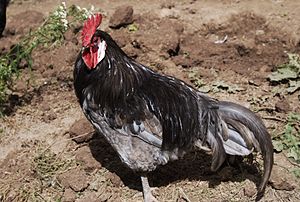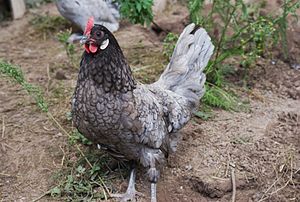Andalusian (chicken)
| Andalusians | |||||
|---|---|---|---|---|---|
|
|||||
| Origin: | Spanish breed | ||||
| Year: | Introduced to Germany in 1872 | ||||
| Colour: | blue-lined, in Spain also unlined | ||||
| Weight: | Rooster 2.5 to 3.0 kg, hen 2.0 to 2.5 kg |
||||
| Laying output per year: | 160 eggs | ||||
| Eggshell color: | White | ||||
| Egg weight: | 58 g | ||||
| Breeding standards: | BDRG | ||||
| List of breeds of chicken | |||||
Andalusians are a breed of domestic fowl from Spain . They are common in Spain and the rest of Europe , although the breed has been more common in Germany since 1872 than in the country of origin. The breed, while making an impressive display, is rare.
The rooster weighs between 2.5 and 3 kg . The hen is lighter at 2.0 to 2.5 kg.
The eggs weigh about 58 g and are white. The laying capacity is around 150 eggs per year. The breed offers a stately and high-ranking appearance. The comb is simple.
The Andalusians have an intermediate inheritance. Statistically, 50% of the offspring are blue animals, and the remaining 50% are divided into white and black animals. Therefore, the effort to preserve appropriately drawn animals is somewhat greater than with other breeds. However, through targeted mating (only pair black with white parent animals), up to 100% correctly drawn animals can be bred.
The development time of the animals to sexual maturity is an average of 5–6 months. Economically, this breed does not play a role and is mainly kept for its aesthetic value.
Andalusians are very closely related to the chicken breeds: Spaniards , Castilians and Minorka .
Dwarf form
The dwarf form is just as rare as the normal form. It was bred in England and Germany and recognized in 1954. The rooster weighs 900 grams and the hen 800 grams. The laying capacity is 100 eggs per year. These are white and weigh 35 grams.
Existence and endangerment
Andalusians are rare and are considered an endangered breed of domestic animal . The BDRG and the GEH have classified the Andalusians in the " Red List of Endangered Livestock Breeds 2013 " in the highest hazard class I (extremely endangered). After that there were only 89 roosters and 285 hens in Germany in 2009.
Individual evidence
- ↑ a b c Walter Schwarz, Armin Six: Hühner, Truthühner, Guinea fowl (= The large poultry standard in color . Volume 1 ). 7th edition, revised and supplemented by Armin Six. Oertel and Spörer, Reutlingen 2004, ISBN 3-88627-511-6 , Andalusier, p. 23 .
- ↑ Red list of domestic livestock breeds in Germany 2013 ( Memento of the original from February 1, 2014 in the Internet Archive ) Info: The archive link was automatically inserted and not yet checked. Please check the original and archive link according to the instructions and then remove this notice.
literature
- Hans-Joachim Schille: Lexicon of the chickens. Komet-Verlag, ISBN 3-89836-447-X .
- W. Schwarz / A. Six (2004): The Great Poultry Standard in Color. Reutlingen: Oertel + Spörer Verlags-GmbH + Co (7th edition).

